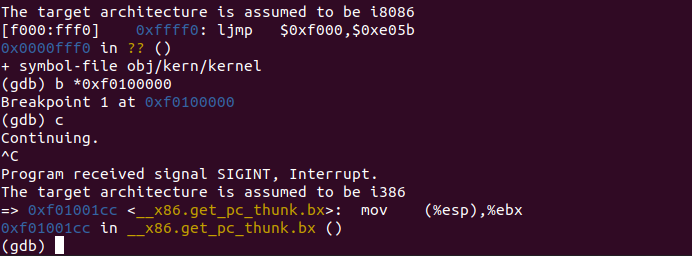Exercise 03
- obj/boot/boot.asm 反汇编文件
- 截取asm部分文件并注释理解
# Set up the important data segment registers (DS, ES, SS).
xorw %ax,%ax # Segment number zero
7c02: 31 c0 xor %eax,%eax
//指令地址: 指令机器码 指令机器码反汇编到的指令
movw %ax,%ds # -> Data Segment
7c04: 8e d8 mov %eax,%ds
movw %ax,%es # -> Extra Segment
7c06: 8e c0 mov %eax,%es
movw %ax,%ss # -> Stack Segment
7c08: 8e d0 mov %eax,%ss
gdb指令:
- 在bootloader第一条语句 0x7C00处设置断点并对比查看后续指令(与boot.asm对比)

4个问题回答:
-
At what point does the processor start executing 32-bit code? What exactly causes the switch from 16- to 32-bit mode?
-
当计算机加电后首先以实模式(real mode)运行,此时为16-bit;
当执行
ljmp $PROT_MODE_CSEG, $protcseg后切换到32-bit,因为此时需要运行保护模式,而linux系统下的保护模式为32-bit
-
-
What is the last instruction of the boot loader executed, and what is the first instruction of the kernel it just loaded?
- boot loader执行的最后一条语句是bootmain子程序中的最后一条语句 ” ((void (*)(void)) (ELFHDR->e_entry))(); “,即跳转到操作系统内核程序的起始指令处。
- 这个第一条指令位于/kern/entry.S文件中,第一句 movw $0x1234, 0x472
-
Where is the first instruction of the kernel?
- 第一条指令位于/kern/entry.S文件中
-
How does the boot loader decide how many sectors it must read in order to fetch the entire kernel from disk? Where does it find this information?
- 首先关于操作系统一共有多少个段,每个段又有多少个扇区的信息位于操作系统文件中的Program Header Table中。这个表中的每个表项分别对应操作系统的一个段。并且每个表项的内容包括这个段的大小,段起始地址偏移等等信息。所以如果我们能够找到这个表,那么就能够通过表项所提供的信息来确定内核占用多少个扇区。
- 那么关于这个表存放在哪里的信息,则是存放在操作系统内核映像文件的ELF头部信息中。
Exercise 04
读pointer.c 代码复习c语言指针用法
#include <stdio.h>
#include <stdlib.h>
void
f(void)
{
int a[4];
int *b = malloc(16); //申请一个15字节的内存块大小并返回一个指针
int *c;
int i;
printf("1: a = %p, b = %p, c = %p
", a, b, c); //打印地址
c = a; //指针C 指向数组a的首地址
for (i = 0; i < 4; i++)
a[i] = 100 + i; //给a数组赋值100~103
c[0] = 200; //给c[0]赋值200, 也就是修改a[0]
printf("2: a[0] = %d, a[1] = %d, a[2] = %d, a[3] = %d
",
a[0], a[1], a[2], a[3]); //打印数组a的值
c[1] = 300; //修改a[1]
*(c + 2) = 301; //指针+2,代表是index+2,指向的是c[2]
3[c] = 302; //c编译器当成*(3+c),故c[3]=302
printf("3: a[0] = %d, a[1] = %d, a[2] = %d, a[3] = %d
",
a[0], a[1], a[2], a[3]); //200 300 301 302
c = c + 1; //c指针前移,指向a[1]
*c = 400; //a[1]=400
printf("4: a[0] = %d, a[1] = %d, a[2] = %d, a[3] = %d
",
a[0], a[1], a[2], a[3]); //200 400 301 302
c = (int *) ((char *) c + 1); //char类型占1个字节,int类型占16位(2字节),所以此时c指针先被转换为char类型,然后+1,相当于指向了下一个字节,即a[1]的第二个字节,然后再改为int*,即控制对象为16位;
*c = 500; //修改c指针指向的内容,a[1]a[2]都会受影响
printf("5: a[0] = %d, a[1] = %d, a[2] = %d, a[3] = %d
",
a[0], a[1], a[2], a[3]); //200 128144 256 302
b = (int *) a + 1; //b指针指向a的下一个对象(后移16个字节)
c = (int *) ((char *) a + 1); //与第一次c的改变类似
printf("6: a = %p, b = %p, c = %p
", a, b, c);
//第6个输出表明指针加减某个整数对应的内存偏移量取决于指针的类型。
}
int
main(int ac, char **av)
{
f();
return 0;
}
更深层解析:https://blog.csdn.net/amgtgsh3150267/article/details/101834733
运行截图

指针复习总结:
- char类型占1个字节;int/short类型占2字节(16位);long类型占4字节
int *ip表明*ip 是 int类型的;*ip=*ip+10就是*ip的内容+10(*ip)++的括号不可以省略,因为*/++运算符是遵循从右至左的结合顺序int *pa;pa+1将指向下一个int对象a[10] ; pa=a;那么pa[i] 等价于*(pa+i)等价于a[i]3[a]也成立,c编译器当成:*(3+i)- int *pa; pa = &a[0] 与 pa = a 等价;
ELF binary 解析
编译并连接C程序时:
- compiler 将(.c)file → (.o)file[包含二进制汇编语言指令]
- linker将所有的compiled objects files 合并成binary image[即 a binary in ELF format]
ELF binary 关注
-
将ELF executable 当作是 a header with loading information
-
关注ELF binary中的变长的program header段(记录program sections的信息) 以及 具体的program sections
-
练习要求:
Examine the full list of the names, sizes, and link addresses of all the sections in the kernel executable
链接地址 & 运行地址
VMA(link address,链接地址):The link address of a section is the memory address from which the section expects to execute.
LMA(load address,加载地址): The load address of a section is the memory address at which that section should be loaded into memory.
补充材料:(清华 ucore)
Link addr& Load addr
Link Address是指编译器指定代码和数据所需要放置的内存地址,由链接器配置。Load Address是指程序被实际加载到内存的位置(由程序加载器ld配置)。一般由可执行文件结构信息和加载器可保证这两个地址相同。Link Addr和LoadAddr不同会导致:
- 直接跳转位置错误
- 直接内存访问(只读数据区或bss等直接地址访问)错误
- 堆和栈等的使用不受影响,但是可能会覆盖程序、数据区域
注意:也存在Link地址和Load地址不一样的情况(例如:动态链接库,即动态重定位的时候)。
补充:程序执行前的步骤:
- 编译-链接-装入
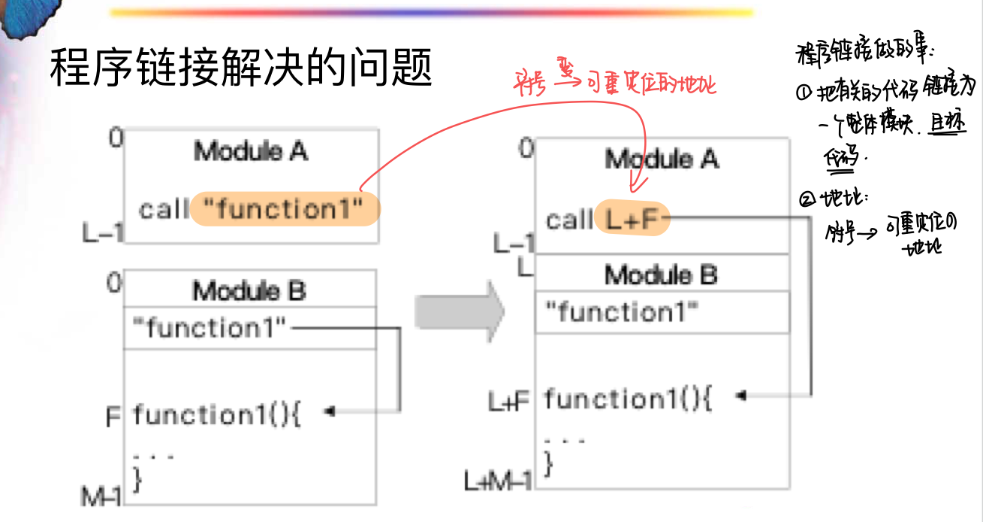
-
装入:
-
绝对装入:固定地址再定位,程序地址在编译链接时直接制定程序在执行时访问的实际存储器地址
-
静态重定位装入:装入程序在程序执行之前地址在定位,执行期间不会改变

-
动态重定位装入:程序装入时不修改逻辑地址,访问物理内存前再实时地修改逻辑地址为物理地址

-
练习
-
objdump指令:objdump命令是Linux下的反汇编目标文件或者可执行文件的命令,它以一种可阅读的格式让你更多地了解二进制文件可能带有的附加信息。 -
objdump -h obj/kern/kernel:

objdump -h obj/boot/boot.out
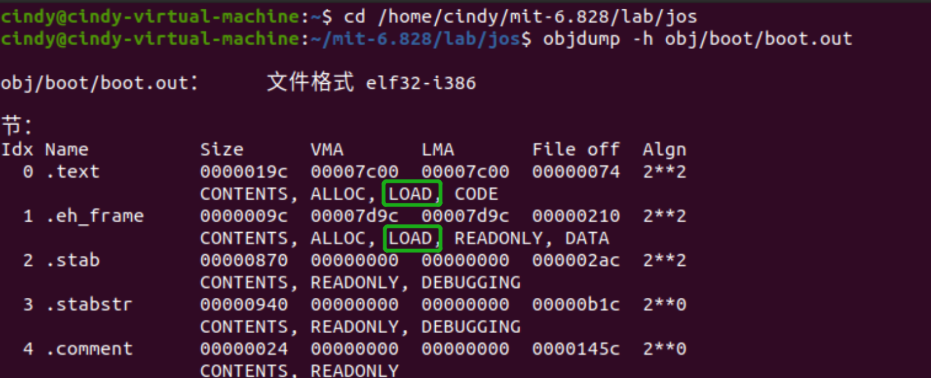
objdump -x obj/kern/kernel"vaddr"Other information for each program header is given, such as the virtual address ,"paddr"the physical address"memsz" and "filesz"the size of the loaded area
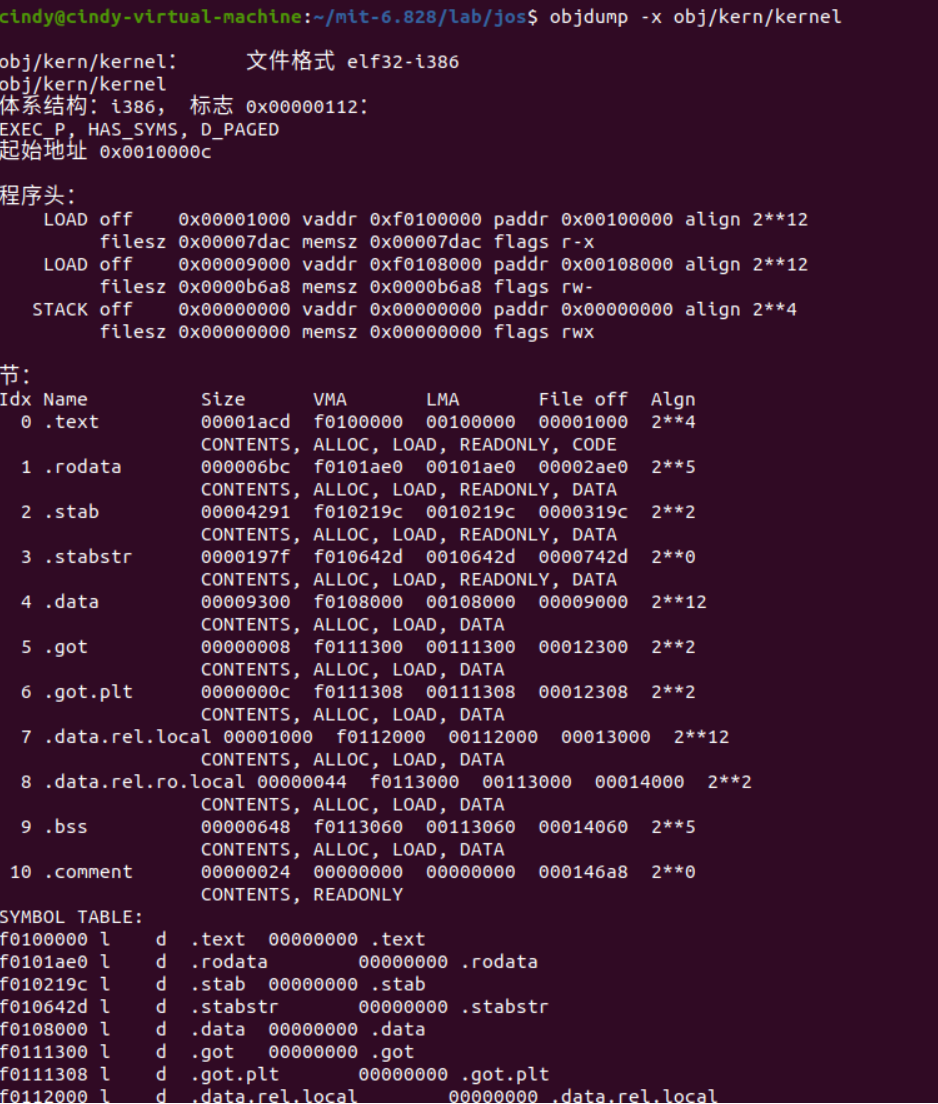
备注:SYMBOL TABLE模块完整代码:
cindy@cindy-virtual-machine:~/mit-6.828/lab/jos$ objdump -x obj/kern/kernel
obj/kern/kernel: 文件格式 elf32-i386
obj/kern/kernel
体系结构:i386, 标志 0x00000112:
EXEC_P, HAS_SYMS, D_PAGED
起始地址 0x0010000c
程序头:
LOAD off 0x00001000 vaddr 0xf0100000 paddr 0x00100000 align 2**12
filesz 0x00007dac memsz 0x00007dac flags r-x
LOAD off 0x00009000 vaddr 0xf0108000 paddr 0x00108000 align 2**12
filesz 0x0000b6a8 memsz 0x0000b6a8 flags rw-
STACK off 0x00000000 vaddr 0x00000000 paddr 0x00000000 align 2**4
filesz 0x00000000 memsz 0x00000000 flags rwx
节:
Idx Name Size VMA LMA File off Algn
0 .text 00001acd f0100000 00100000 00001000 2**4
CONTENTS, ALLOC, LOAD, READONLY, CODE
1 .rodata 000006bc f0101ae0 00101ae0 00002ae0 2**5
CONTENTS, ALLOC, LOAD, READONLY, DATA
2 .stab 00004291 f010219c 0010219c 0000319c 2**2
CONTENTS, ALLOC, LOAD, READONLY, DATA
3 .stabstr 0000197f f010642d 0010642d 0000742d 2**0
CONTENTS, ALLOC, LOAD, READONLY, DATA
4 .data 00009300 f0108000 00108000 00009000 2**12
CONTENTS, ALLOC, LOAD, DATA
5 .got 00000008 f0111300 00111300 00012300 2**2
CONTENTS, ALLOC, LOAD, DATA
6 .got.plt 0000000c f0111308 00111308 00012308 2**2
CONTENTS, ALLOC, LOAD, DATA
7 .data.rel.local 00001000 f0112000 00112000 00013000 2**12
CONTENTS, ALLOC, LOAD, DATA
8 .data.rel.ro.local 00000044 f0113000 00113000 00014000 2**2
CONTENTS, ALLOC, LOAD, DATA
9 .bss 00000648 f0113060 00113060 00014060 2**5
CONTENTS, ALLOC, LOAD, DATA
10 .comment 00000024 00000000 00000000 000146a8 2**0
CONTENTS, READONLY
SYMBOL TABLE:
f0100000 l d .text 00000000 .text
f0101ae0 l d .rodata 00000000 .rodata
f010219c l d .stab 00000000 .stab
f010642d l d .stabstr 00000000 .stabstr
f0108000 l d .data 00000000 .data
f0111300 l d .got 00000000 .got
f0111308 l d .got.plt 00000000 .got.plt
f0112000 l d .data.rel.local 00000000 .data.rel.local
f0113000 l d .data.rel.ro.local 00000000 .data.rel.ro.local
f0113060 l d .bss 00000000 .bss
00000000 l d .comment 00000000 .comment
00000000 l df *ABS* 00000000 obj/kern/entry.o
f010002f l .text 00000000 relocated
f010003e l .text 00000000 spin
00000000 l df *ABS* 00000000 entrypgdir.c
00000000 l df *ABS* 00000000 init.c
00000000 l df *ABS* 00000000 console.c
f01001d0 l F .text 0000001e serial_proc_data
f01001ee l F .text 00000062 cons_intr
f0113080 l O .bss 00000208 cons
f0100250 l F .text 0000012e kbd_proc_data
f0113060 l O .bss 00000004 shift.1385
f0101ca0 l O .rodata 00000100 shiftcode
f0101ba0 l O .rodata 00000100 togglecode
f0113000 l O .data.rel.ro.local 00000010 charcode
f010037e l F .text 00000203 cons_putc
f0113288 l O .bss 00000002 crt_pos
f0113290 l O .bss 00000004 addr_6845
f011328c l O .bss 00000004 crt_buf
f0113294 l O .bss 00000001 serial_exists
f0111200 l O .data 00000100 normalmap
f0111100 l O .data 00000100 shiftmap
f0111000 l O .data 00000100 ctlmap
00000000 l df *ABS* 00000000 monitor.c
f0113010 l O .data.rel.ro.local 00000018 commands
00000000 l df *ABS* 00000000 printf.c
f0100a2c l F .text 00000026 putch
00000000 l df *ABS* 00000000 kdebug.c
f0100aa5 l F .text 000000f5 stab_binsearch
00000000 l df *ABS* 00000000 printfmt.c
f0100dac l F .text 000000be printnum
f0100e6a l F .text 00000021 sprintputch
f0113028 l O .data.rel.ro.local 0000001c error_string
f01012fe l .text 00000000 .L20
f0100fa2 l .text 00000000 .L36
f01012eb l .text 00000000 .L35
f0100f5e l .text 00000000 .L34
f0100f27 l .text 00000000 .L66
f0100f8a l .text 00000000 .L33
f0100f30 l .text 00000000 .L32
f0100f39 l .text 00000000 .L31
f0100fc5 l .text 00000000 .L30
f010112f l .text 00000000 .L29
f0100fe1 l .text 00000000 .L28
f0100fb9 l .text 00000000 .L27
f010120a l .text 00000000 .L26
f010122a l .text 00000000 .L25
f010103a l .text 00000000 .L24
f01011b8 l .text 00000000 .L23
f0101296 l .text 00000000 .L21
00000000 l df *ABS* 00000000 readline.c
f01132a0 l O .bss 00000400 buf
00000000 l df *ABS* 00000000 string.c
00000000 l df *ABS* 00000000
f0111308 l O .got.plt 00000000 _GLOBAL_OFFSET_TABLE_
f0100da8 g F .text 00000000 .hidden __x86.get_pc_thunk.cx
f010000c g .text 00000000 entry
f01014f6 g F .text 00000026 strcpy
f01005ac g F .text 00000021 kbd_intr
f01008b1 g F .text 0000000a mon_backtrace
f010010e g F .text 0000006e _panic
f0100784 g F .text 00000000 .hidden __x86.get_pc_thunk.si
f01000aa g F .text 00000064 i386_init
f01016ac g F .text 00000066 memmove
f010138c g F .text 0000001e snprintf
f0100eac g F .text 0000047d vprintfmt
f01005cd g F .text 0000005a cons_getc
f0100a8d g F .text 00000018 cprintf
f0101712 g F .text 0000001a memcpy
f01013aa g F .text 00000109 readline
f0110000 g O .data 00001000 entry_pgtable
f0100040 g F .text 0000006a test_backtrace
f0101329 g F .text 00000063 vsnprintf
f0113060 g .bss 00000000 edata
f0100627 g F .text 00000126 cons_init
f0100780 g F .text 00000000 .hidden __x86.get_pc_thunk.ax
f010642c g .stab 00000000 __STAB_END__
f010642d g .stabstr 00000000 __STABSTR_BEGIN__
f0101980 g F .text 0000014d .hidden __umoddi3
f0100581 g F .text 0000002b serial_intr
f0101870 g F .text 0000010a .hidden __udivdi3
f0100776 g F .text 0000000a iscons
f010178a g F .text 000000de strtol
f01014cf g F .text 00000027 strnlen
f010151c g F .text 00000029 strcat
f01136a4 g O .bss 00000004 panicstr
f01136a0 g .bss 00000000 end
f010017c g F .text 00000050 _warn
f0101640 g F .text 00000020 strfind
f0101acd g .text 00000000 etext
0010000c g .text 00000000 _start
f0101576 g F .text 0000003f strlcpy
f01015df g F .text 0000003c strncmp
f0101545 g F .text 00000031 strncpy
f01001cc g F .text 00000000 .hidden __x86.get_pc_thunk.bx
f010172c g F .text 0000003d memcmp
f010074d g F .text 00000014 cputchar
f0101660 g F .text 0000004c memset
f0100761 g F .text 00000015 getchar
f0100e8b g F .text 00000021 printfmt
f0107dab g .stabstr 00000000 __STABSTR_END__
f01015b5 g F .text 0000002a strcmp
f0100b9a g F .text 0000020e debuginfo_eip
f0100a52 g F .text 0000003b vcprintf
f0110000 g .data 00000000 bootstacktop
f0112000 g O .data.rel.local 00001000 entry_pgdir
f0108000 g .data 00000000 bootstack
f010219c g .stab 00000000 __STAB_BEGIN__
f01014b3 g F .text 0000001c strlen
f010161b g F .text 00000025 strchr
f01007dc g F .text 000000d5 mon_kerninfo
f01008bb g F .text 00000171 monitor
f0101769 g F .text 00000021 memfind
f0100788 g F .text 00000054 mon_help
Exercise 05
上面引入了VMA 和 LMA,理解如下:
- 链接地址:可以理解为通过编译器链接器处理形成的可执行程序中指令的地址,即逻辑地址
- 加载地址则是可执行文件真正被装入内存后运行的地址,即物理地址
⚠ 由于在boot loader运行时还没有任何的分段处理机制,或分页处理机制,所以boot loader可执行程序中的链接地址就应该等于加载地址。
- step01:拷贝原有的obj/boot/boot.asm 以便用来比较
- step02:打开boot/Makefrag文件,修改链接地址,这里改为
0x7E00
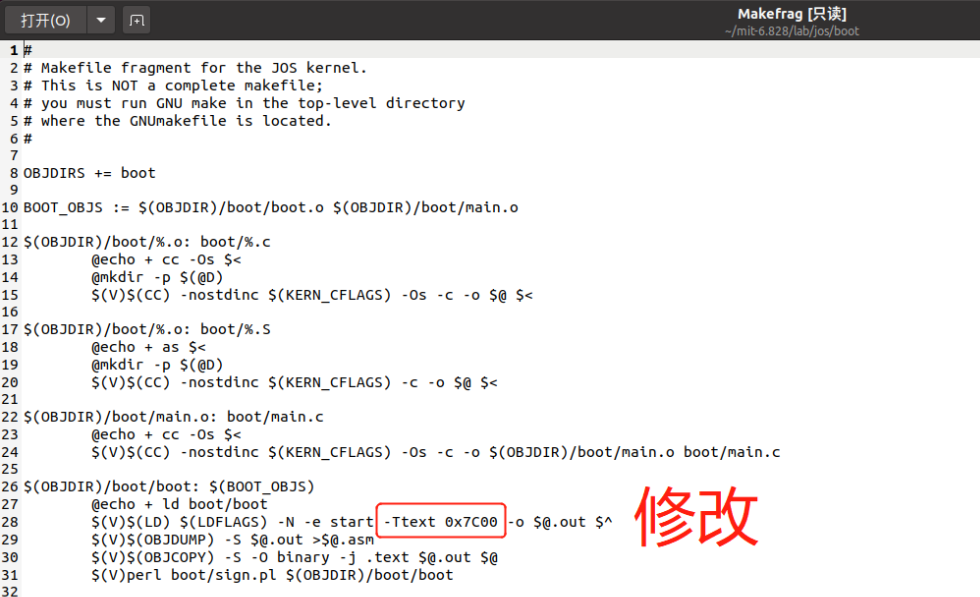
- step03:在lab下输入make,重新编译内核,首先查看一下obj/boot/boot.asm,并且和之前的那个obj/boot/boot.asm文件做比较。下图是新编译出来的boot.asm:

下图是修改之前的boot.asm
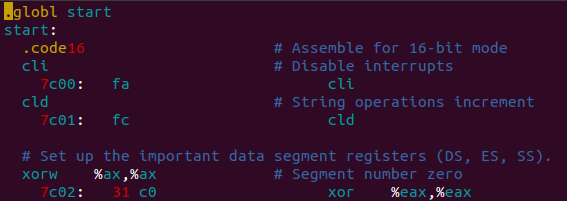
可以看出,二者区别在于可执行文件中的链接地址不同了,原来是从0x7C00开始,现在则是从0x7E00开始
- step04:然后我们还是按照原来的方式,调试一下内核:
由于BIOS会把boot loader程序默认装入到0x7c00处,所以我们还是再0x7C00处设置断点,并且运行到那里,结果发现如下:
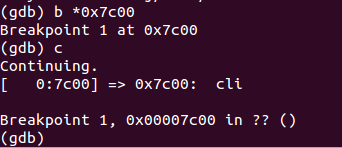
可见第一条执行指令仍旧是正确的,所以我们接着往下一步步运行。
接下来的几步仍旧是正常的,但是直到运行到一条指令:

图中的0x7c1e处指令,
lgdtw 0x7e64
这条指令我们之前讲述过,是把指令后面的值所指定内存地址处后6个字节的值输入全局描述符表寄存器GDTR,但是当前这条指令读取的内存地址是0x7e64,我们在图中也展示了一下这个地址处后面6个单元存放的值,发现是全部是0。这肯定是不对的,正确的应该是在0x7c64处存放的值,即图中最下面一样的值。可见,问题出在这里,GDTR表的值读取不正确,这是实现从实模式到保护模式转换的非常重要的一步。
我们可以继续运行,知道发现下面这句:

正常来说,0x7c2d处的指令
ljmp $0x08m $0x7e32
应该跳转到的地址应该就是ljmp的下一条指令地址,即0x7c32,但是这里给的值是0x7e32,所以造成错误,此时下条指令变成了0xfe05b。 然后后面 就..全面崩盘
Excersise 06:
- kernel起始地址查看
objdump -f obj/kern/kernel

- 理解boot/main.c 里面的ELF loader
minimal ELF loader 把kernel里面的每个section从disk 按照section's load address读进memory之后, 跳到了kernel的entry point
- 知识概要总结
BIOS负责执行基本的系统初始化,从某些适当的位置(如 floppy disk(软盘), hard disk, CD-ROM, or the network)加载操作系统,并将机器的控制权给操作系统(通过jmp指令将CS:IP设置为0000:7c00,0x7c00是the boot sector被加载到的物理地址)- ⚠
the boot loader将处理器从16-bit real model切换到32-bit protected model,使得1M以上的内存地址可以访问(主要boot.S完成。将控制信号传递0x60与0x64端口,加载GDT表,将CR0的bit0位设为1,call bootmain)。还从硬盘中读取内核到内存并跳转到内核入口地址(主要main.c完成。先读取ELF program headers,然后通过ELFHDR内的信息将kernel加载到内存正确位置,最后跳转内核入口地址0x00100000) - the boot loader将内核加载到内存的物理地址(加载地址)是
0x00100000,但内核在内存中的虚拟地址(链接地址)是0xf0100000 - CR0中的两个控制位
PG (Paging)和PE(Protection Enable)。只有在保护方式下(PE=1)分页机制才可能生效。PE=1, PG=1,分页机制生效,把线性地址转换为物理地址。PE=1, PG=0,分页机制无效,线性地址就直接作为物理地址。 - 数据在内存中有
大端(big-endian)格式–高尾端,尾端放在高地址处和小端(little-endian)格式—低尾端, 尾端放在低地址处 backtrace函数实现的关键在于ebp。当前ebp指向当前子程序的栈帧(frame)基地址,地址内存的是caller的栈帧基地址,里面存的又是再外层的caller的栈帧基地址,这样就可以区分出每一层程序的栈帧,从而实现回溯。
- 开机第一条指令:0xffff0 BIOS系统启动,这里只是存放了一条跳转指令,
- BIOS 基本输入/输出系统,其本质是一个固化在主板Flash/CMOS上的软件)和位于软盘/硬盘引导扇区中的OS Boot Loader(在ucore中的bootasm.S和bootmain.c)一起组成。通过跳转指令跳到BIOS例行程序起始点(0xe05b)。BIOS做完计算机硬件自检和初始化后,会选择一个启动设备(例如软盘、硬盘、光盘等),并且读取该设备的第一扇区(即主引导扇区或启动扇区)到内存一个特定的地址0x7c00处,然后CPU控制权会转移到那个地址继续执行。
- boot loader 加载内核并跳到内核入口 0x0010000c
- 注意:内核加载到内存的物理地址(加载地址)是
0x00100000,但内核在内存中的虚拟地址(链接地址)是0xf0100000
- Exercise 06
- BIOS切换到boot loader之前,检查内存
0x100000处8个word(此处1个word=2bytes)- 往后8个 word全是0
- 当boot loader将内核加载到内存之后,再检查
- 往后8个word有内容了
※:进入内核后,内核已经加载到以0x100000为始地址的主存空间,所以相邻地址都有内容了
重点:
-
boot loader 进入到内核:
- 从kernel文件中可以看到起始地址为
0x10000c
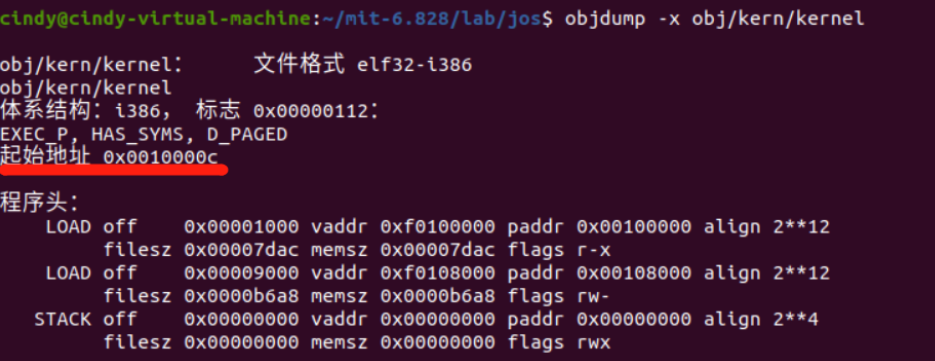
- 从main.c文件中看到e_entry的地址:
- 从kernel文件中可以看到起始地址为

- 疑惑:

